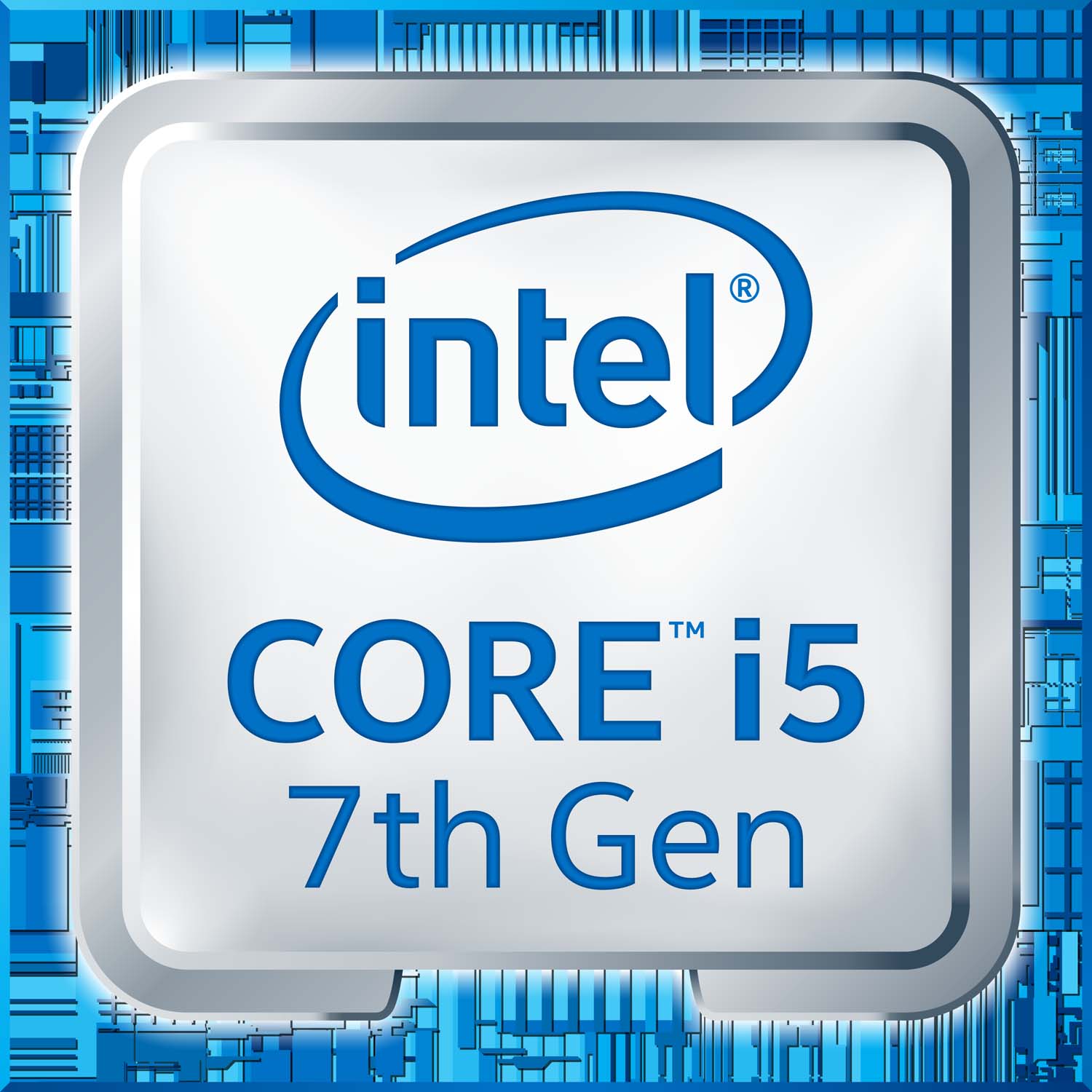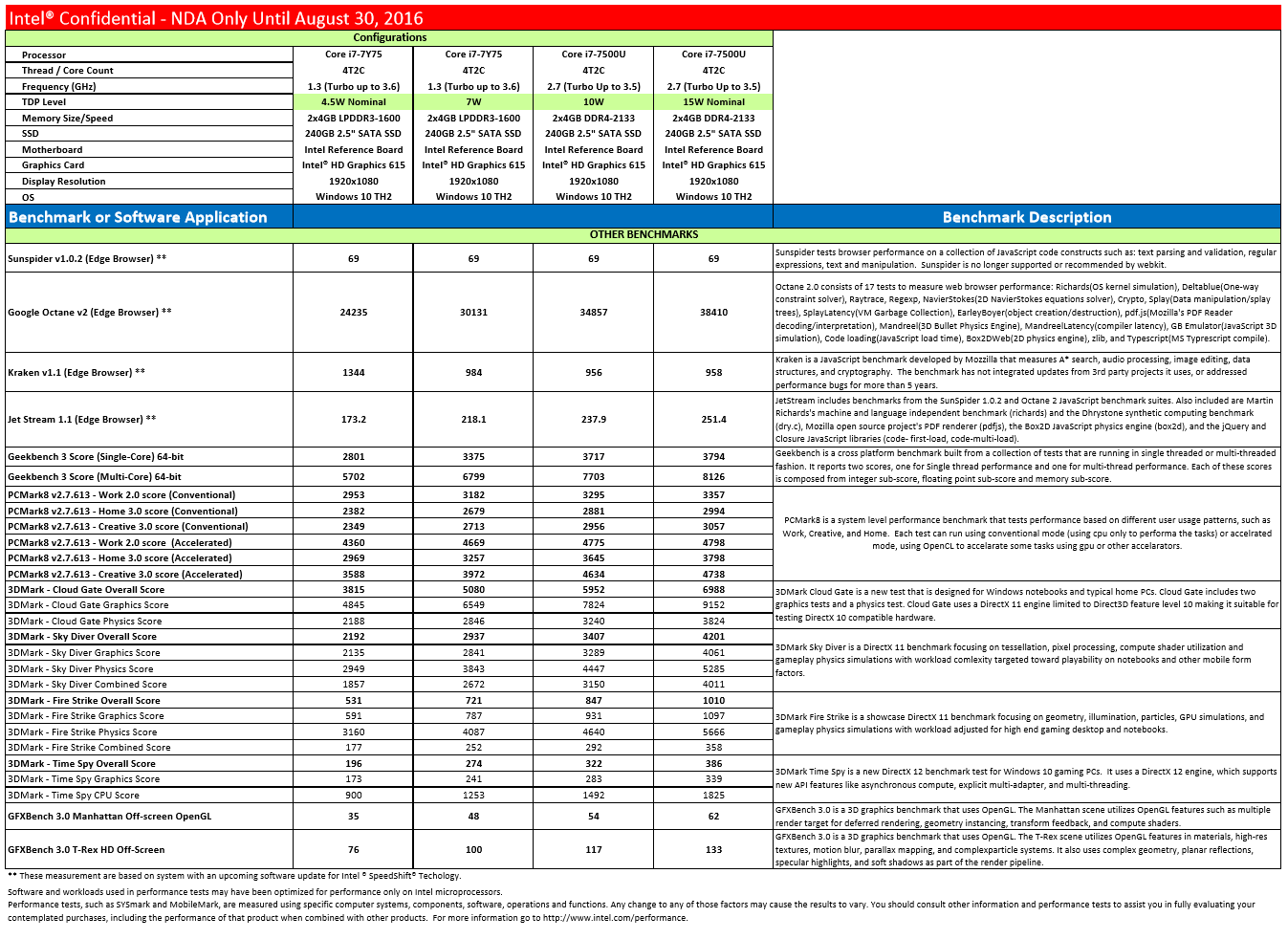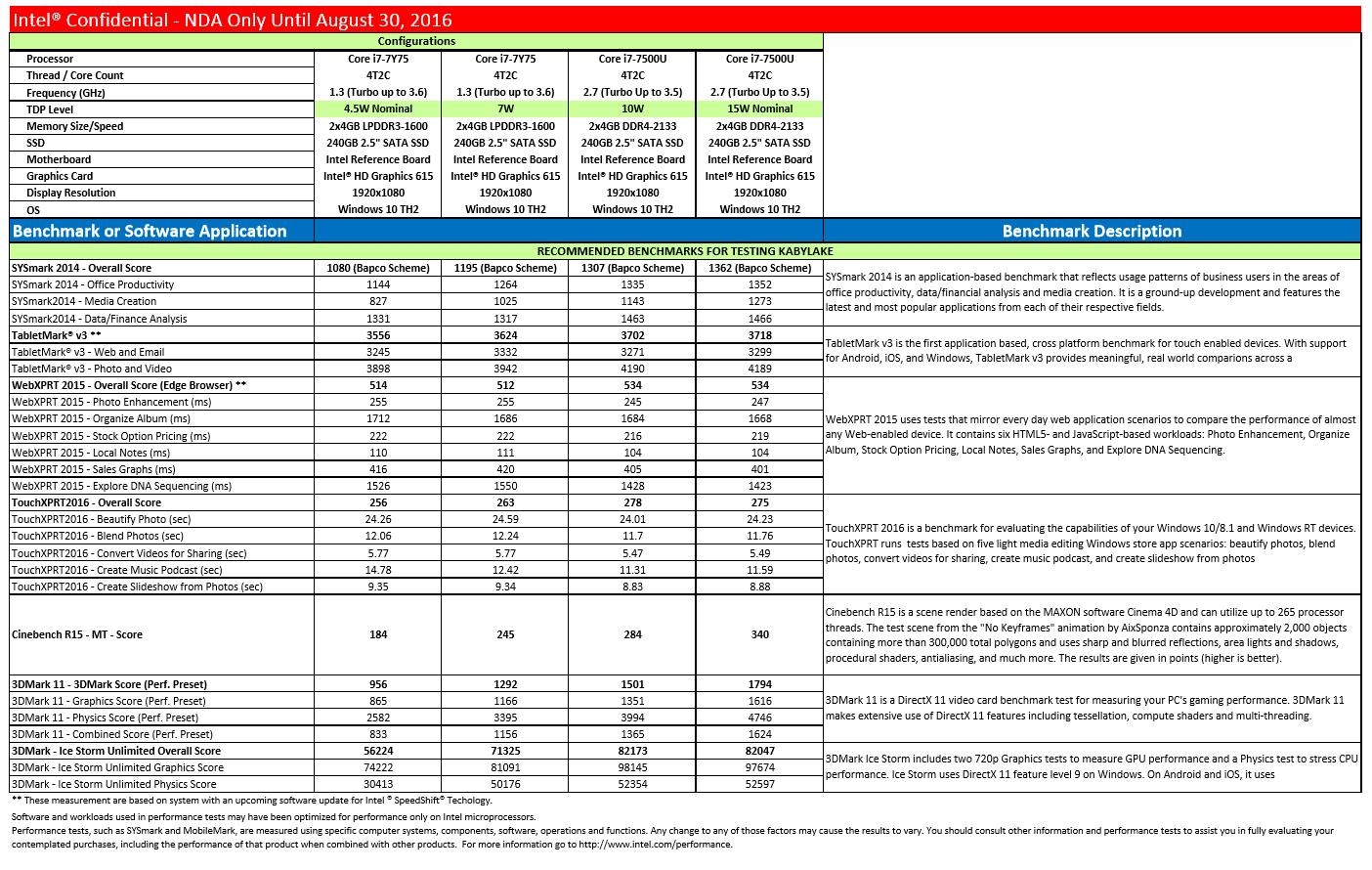Intel's Kaby Lake Branding Confounds, But The Real Devil Is In The TDP Details
All the king's horses and all the king's men cannot fix the trouble Intel has gotten itself into with the fractured re-branding effort behind its 7th-gen Core (Kaby Lake) processors. The new branding scheme is somewhat confusing because it discards the previous "m7" and "m5" nomenclature for Intel's low-power SKUs and brands them as "i5" and "i7" parts.
This will surely confuse shoppers, but the disappointing news is that the muddy branding waters hide a deeper undercurrent of obfuscation. OEMs can restrict Kaby Lake TDPs, which adjusts performance, into lower settings that extend below the advertised 4.5W and 15W power ranges. By the same token, Intel also allows vendors to adjust the TDP settings to exceed the normal specifications, which means there is an equal (though less likely) chance that the processors will feature higher-than-normal specs.
Intel has not defined a steadfast rule that requires OEMs to disclose the TDP settings on their packaging or in the marketing materials, which means you could be playing the silicon lottery when you purchase a laptop or 2-in-1. Let's untangle the web of confusing branding and dive into the deeper topic of TDP adjustments.
The Skewed SKU Branding
Whereas Intel used "Core m" nomenclature for its 4.5W Skylake chips, the 4.5W Kaby Lake SKUs bear the "i5" and "i7" branding that was used for 15W and higher Skylake parts. Only the lowest-end Core m chip in the Kaby Lake family, the m3, retains the same branding across both generations. Some proclaim the move to i7 and i5 branding is vague, at best, and doesn't help the "normal" customer discern between the 4.5W and 15W processors.
Perhaps more troubling is that vendors can configure the TDP either above or below the 4.5W setting. For instance, the Y-Series processors feature configurable TDP (cTDP) that includes a 3.5W "Down" setting, in addition to a 4.5W "Nominal" and 7W "Up" setting.
The vendors can select the various TDP ranges either statically or dynamically. Intel describes the feature in its launch-day documentation;
With Configurable TDP, the processor is now capable of modulating the maximum sustained power vs. performance. Configurable TDP thus provides design and performance flexibility to control system performance based on the cooling capability and usage scenarios. For example, a detachable Ultrabook may need more performance when used in a full clamshell mode (vs. tablet mode), or when balanced performance is needed in a quiet conference room setting.
Get Tom's Hardware's best news and in-depth reviews, straight to your inbox.
A static 3.5W setting will allow the device to fit in smaller devices due to the lowered thermal envelope, and it will also boost battery life (which is the primary reason vendors adjust TDP). Unfortunately, this permanent setting lowers performance significantly, and the vendor is not required to disclose the TDP configuration, so many do this with little fanfare. The end user cannot adjust the statically-assigned TDP value. A vendor could also choose to manufacture a beefier device that trades battery life for more performance. This technique would boost the 4.5W processor up to 7W, but one could naturally assume the vendor would emblazon this enhancement on the packaging.
Dynamic TDP indicates that the device can employ on-the-fly cTDP adjustments based on sensor feedback, such as device orientation or temperature sensors. Dynamic cTDP adjustments are helpful to throttle performance when the device is hot, such as outside on a sunny day, which will help keep the chip within a safe thermal envelope. As stated in our recent Kaby Lake debut article:
The "skin" temperature sensors allow the device to detect and adjust frequencies, and the device can choose to stay in a Turbo Boost state for longer periods of time based upon the thermal headroom. Accelerometers also allow the device to adjust performance based on device orientation. For instance, the device will switch to a higher-power mode when it is in a static 45-degree orientation (which indicates docking), as opposed to a 90-degree orientation, which indicates a user is holding it.
AMD also allows vendors to adjust the TDP range of the Summit Ridge and Bristol Ridge APUs, though it's unclear if it supports dynamic adjustments. AMD encountered some customer pushback when it originally added the feature because OEMs did not disclose the actual TDP settings. The company reigned in the configurable TDP range with its newest APUs to discourage misleading adjustments.
Y-Series
| Y-Series Processors | 7th Gen Core i7 | 6th Gen Core m7 | 7th Gen Core i5 | 6th Gen Core m5 | 7th Gen Core m3 | 6th Gen Core m3 |
|---|---|---|---|---|---|---|
| Processor | i7-7Y75 | m7-6Y75 | i5-7Y54 | m5-6Y54 | m3-7Y30 | m3-6Y30 |
| Socket | FCBGA 1515 | FCBGA 1515 | FCBGA 1515 | FCBGA 1515 | FCBGA 1515 | FCBGA 1515 |
| Cores/Threads | 2/4 | 2/4 | 2/4 | 2/4 | 2/4 | 2/4 |
| Power | 4.5W | 4.5W | 4.5W | 4.5W | 4.5W | 4.5W |
| Base Frequency (GHz) | 1.3 | 1.2 | 1.2 | 1.1 | 1 | 0.9 |
| Max. Single-Core Frequency (GHz) | 3.6 | 3.1 | 3.2 | 2.7 | 2.6 | 2.2 |
| Max. Threaded Frequency (GHz) | 3.4 | 2.9 | 2.8 | 2.4 | 2.4 | 2 |
| Graphics | HD Graphics 615 | HD Graphics 515 | HD Graphics 615 | HD Graphics 515 | HD Graphics 615 | HD Graphics 515 |
U-Series
The Kaby Lake U-Series processors also feature the same configurable TDP range, albeit to a larger extent. The "Down" setting brings TDP down to 7.5W, and it also features "Nominal" 15W and "Up" 25W profiles. The i7 and i5 branding remain the same.
| U-Series Processors | 7th Gen Core i7 | 6th Gen Core i7 | 7th Gen Core i5 | 6th Gen Core i5 | 7th Gen Core i3 | 6th Gen Core i3 |
|---|---|---|---|---|---|---|
| Processor | i7-7500U | i7-6500U | i5-7200U | i5-6200U | i3-7100U | i3-6100U |
| Socket | FCBGA 1356 | FCBGA 1356 | FCBGA 1356 | FCBGA 1356 | FCBGA 1356 | FCBGA 1356 |
| Cores/Threads | 2/4 | 2/4 | 2/4 | 2/4 | 2/4 | 2/4 |
| Power | 15W | 15W | 15W | 15W | 15W | 15W |
| Base Frequency (GHz) | 2.7 | 2.5 | 2.5 | 2.3 | 2.4 | 2.3 |
| Max. Single-Core Frequency (GHz) | 3.5 | 3.1 | 3.1 | 2.8 | N/A | N/A |
| Max. Threaded Frequency (GHz) | 3.5 | 2.6 | 3.1 | 2.4 | N/A | N/A |
| Graphics | HD Graphics 620 | HD Graphics 520 | HD Graphics 620 | HD Graphics 520 | HD Graphics 620 | HD Graphics 520 |
Staving Off The Wolves
Intel probably had the inclination that discarding the m7 and m5 branding would be the source of some consternation, so the company made a change to the Intel Core badges that are on the outside of the end user products. In the past, there was no indication of which generation of the processor was inside the device, but the new branding scheme brings the "7th Gen" moniker to the badge.
This might be helpful if a seventh-generation 4.5W i5 were comparable to a seventh-generation 15W i5 processor, but they aren't. Also, there isn't even a sixth-generation 4.5W i7 or i5 in existence, so it actually clarifies nothing.
Confused Yet?
Intel already has a somewhat confusing delineation between its "generations" branding and codenames, such as "Kaby Lake." For the record, Intel does not specifically market devices with the codename in an attempt to alleviate the confusion, but it actually just confuses the end user even more. Is it a "7th-gen Core" or a "Kaby Lake Core?" Well, confused customer, it's both.
Bringing the delineated 4.5W and 15W i5 and i7 branding into the picture just creates more confusion, and it does nothing to help us determine the actual cTDP setting.
The cTDP feature is useful, particularly for dynamic adjustments, but unfortunately OEMs can potentially abuse the feature. Because there isn't a requirement for the vendor to disclose the setting, you will have no idea if the device you just bought is even running at full speed. Clarification will require a trip to the vendor's detailed specs, and in some cases, a direct inquiry.
The new branding makes it a whole lot harder for the average user to determine just what Intel is inside (as it were), and the cTDP settings make it even harder to determine how fast it is.
Side note: Intel provided performance data of a few of its new SKUs, which were tested at various cTDP settings. Feel free to peruse the two images below to see the difference in performance. Unfortunately, Intel did not provide performance measurements with the restricted TDPs.

Paul Alcorn is the Editor-in-Chief for Tom's Hardware US. He also writes news and reviews on CPUs, storage, and enterprise hardware.
-
turkey3_scratch Here come the threads, "How come my games start to lag when I pick up my laptop?"Reply -
BadActor I'd really like to see how the HD 615 and 620 graphics perform in games with the...ahem, i7.Reply -
turkey3_scratch What I don't understand are Intel's tricks to making the TDP so low. We have the I7-7500U. 2.7Ghz turboes to 3.5Ghz. Then we have the desktop Pentium G4400 3.3Ghz with a 54W TDP. Seems like a large gap to me. Then again their TDP numbers are sometimes inaccurate I think.Reply -
Discorama Turbo frequencies are pushed pretty high. Too bad most of the devices these CPUs will be used in will throttle down due to heat and never use them.Reply
But yeah, really comes down to how well the 615/620 perform as that is always Intel's weakness. -
jimmysmitty Reply18533742 said:What I don't understand are Intel's tricks to making the TDP so low. We have the I7-7500U. 2.7Ghz turboes to 3.5Ghz. Then we have the desktop Pentium G4400 3.3Ghz with a 54W TDP. Seems like a large gap to me. Then again their TDP numbers are sometimes inaccurate I think.
Why are you comparing a low power laptop chip to a desktop chip?
Intels TDP is normally the max power a CPU can dissipate before it throttles. For the i7-7500U it is a low power part so it has limitations put in place to keep it from hitting higher power numbers.
One benefit the i7 has is a more mature process. One example is the i7 4770K and i7 4790K:
http://ark.intel.com/compare/80807,75123
The i7 4790K had a 4w TDP disadvantage but a 500MHz clock speed advantage and clocked higher in overclocking. A more mature process tech and tweaks can help the TDP of a CPU. -
turkey3_scratch Reply18533927 said:18533742 said:What I don't understand are Intel's tricks to making the TDP so low. We have the I7-7500U. 2.7Ghz turboes to 3.5Ghz. Then we have the desktop Pentium G4400 3.3Ghz with a 54W TDP. Seems like a large gap to me. Then again their TDP numbers are sometimes inaccurate I think.
Why are you comparing a low power laptop chip to a desktop chip?
Intels TDP is normally the max power a CPU can dissipate before it throttles. For the i7-7500U it is a low power part so it has limitations put in place to keep it from hitting higher power numbers.
One benefit the i7 has is a more mature process. One example is the i7 4770K and i7 4790K:
http://ark.intel.com/compare/80807,75123
The i7 4790K had a 4w TDP disadvantage but a 500MHz clock speed advantage and clocked higher in overclocking. A more mature process tech and tweaks can help the TDP of a CPU.
I was just wondering, if you have a laptop and desktop chip of the same architecture. Let's say they have the same number of cores and threads. Let's say same frequency. Does the laptop part still perform worse and cooler for any reason other than less cache? -
TJ Hooker Reply
An educated guess:18534004 said:18533927 said:18533742 said:What I don't understand are Intel's tricks to making the TDP so low. We have the I7-7500U. 2.7Ghz turboes to 3.5Ghz. Then we have the desktop Pentium G4400 3.3Ghz with a 54W TDP. Seems like a large gap to me. Then again their TDP numbers are sometimes inaccurate I think.
Why are you comparing a low power laptop chip to a desktop chip?
Intels TDP is normally the max power a CPU can dissipate before it throttles. For the i7-7500U it is a low power part so it has limitations put in place to keep it from hitting higher power numbers.
One benefit the i7 has is a more mature process. One example is the i7 4770K and i7 4790K:
http://ark.intel.com/compare/80807,75123
The i7 4790K had a 4w TDP disadvantage but a 500MHz clock speed advantage and clocked higher in overclocking. A more mature process tech and tweaks can help the TDP of a CPU.
I was just wondering, if you have a laptop and desktop chip of the same architecture. Let's say they have the same number of cores and threads. Let's say same frequency. Does the laptop part still perform worse and cooler for any reason other than less cache?
1) Unlike desktop parts, mobile parts (especially -U and -Y) are typically only expected to be able to reach maximum boost clocks for short periods before throttling. This is why a low power mobile CPU may perform worse than a desktop chip with all the same specs (including boost clock).
2) I believe mobile parts are binned for low power consumption (i.e. low leakage) which, combined with 1), explain why they can have lower power consumption than a desktop part with seemingly equal specs.
Also, like you said, TDP isn't really an accurate measure of power consumption. It's actual purpose is to designate the general level of performance (i.e. heat dissipation capability) a heatsink would need to cool that part. The fact that a i5 6600 and 6400 have identical TDP shows that it's not exact. If I were to speculate, maybe Intel really dials in the rated TDP on their mobile parts because of how constrained cooling/power is on the kinds of systems that would use those chips, whereas with desktop they just ballpark it (and overestimate for the sake of erring on the side of caution), because it's not as important. Like I said though, this is just my own thoughts on the matter.
-
bit_user Good reporting, Paul.Reply
The new branding makes it a whole lot harder for the average user to determine just what Intel is inside (as it were)
Oh... Snap!
I'm not too worried about manufacturers permanently down-clocking a more expensive part, because it would cost them more than buying a cheaper SKU and overclocking it.
My guess is that people are going to spend a lot of time looking at graphs of clock speeds, but that's already the case, for mobile.


